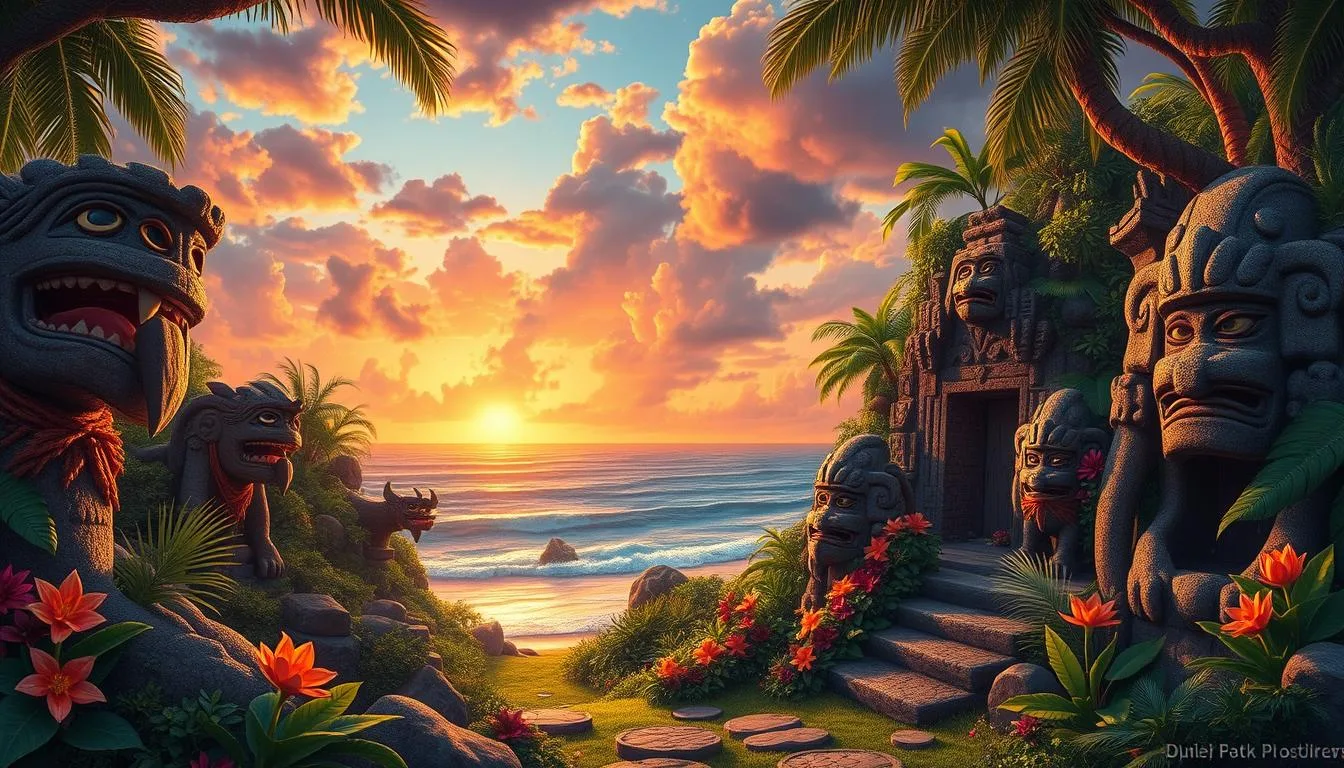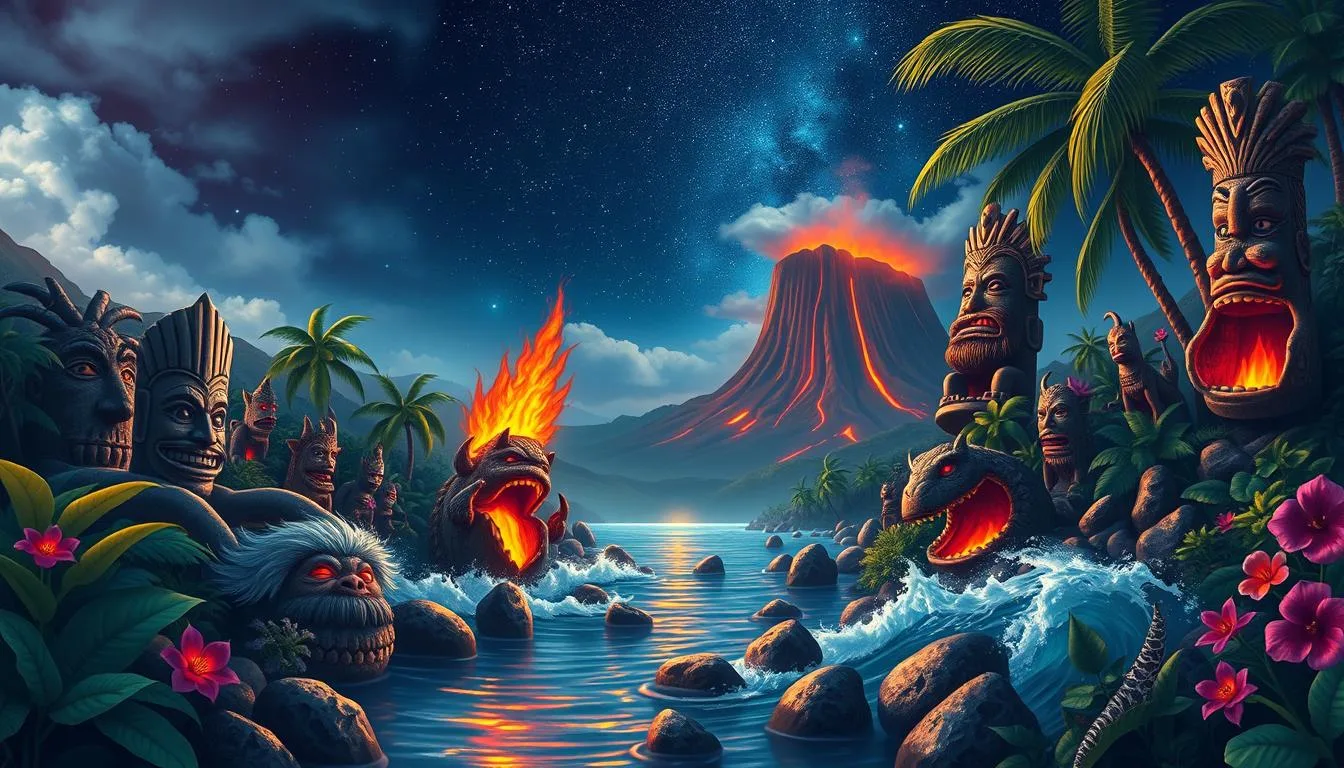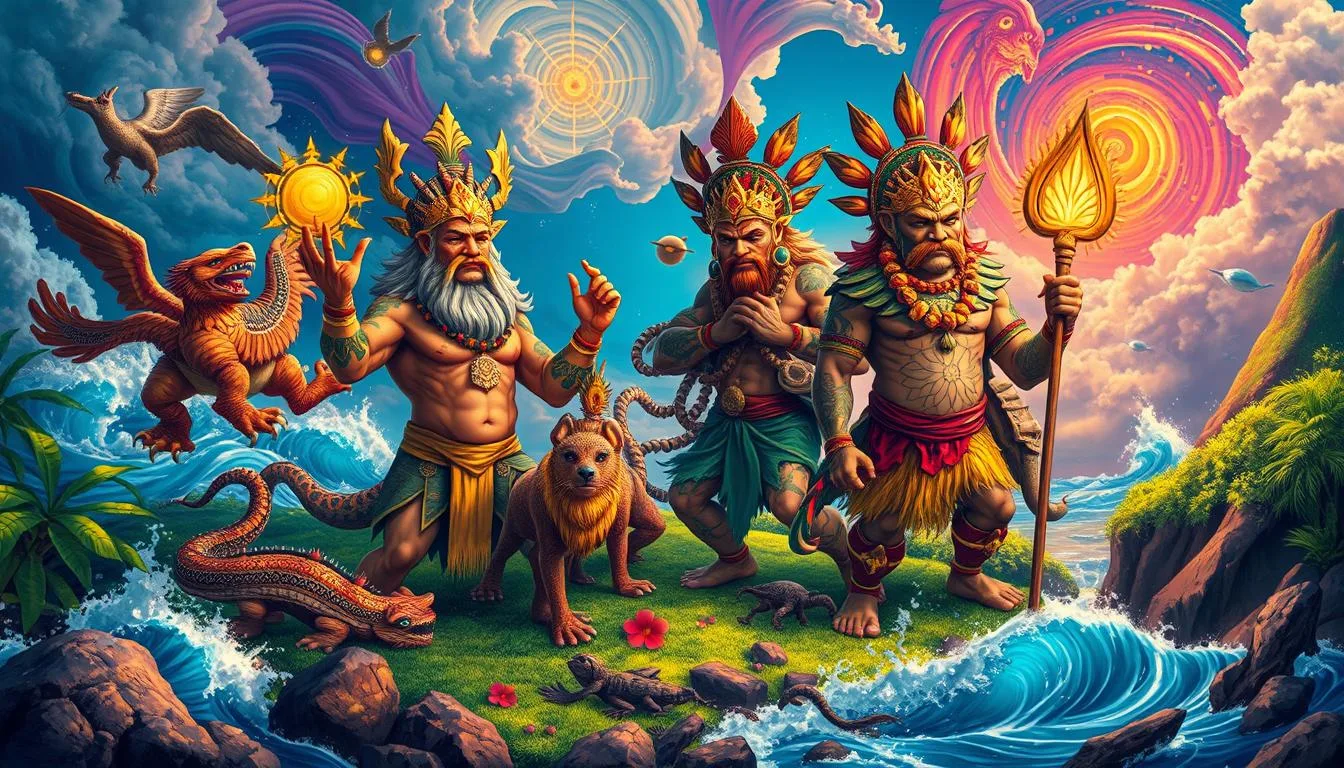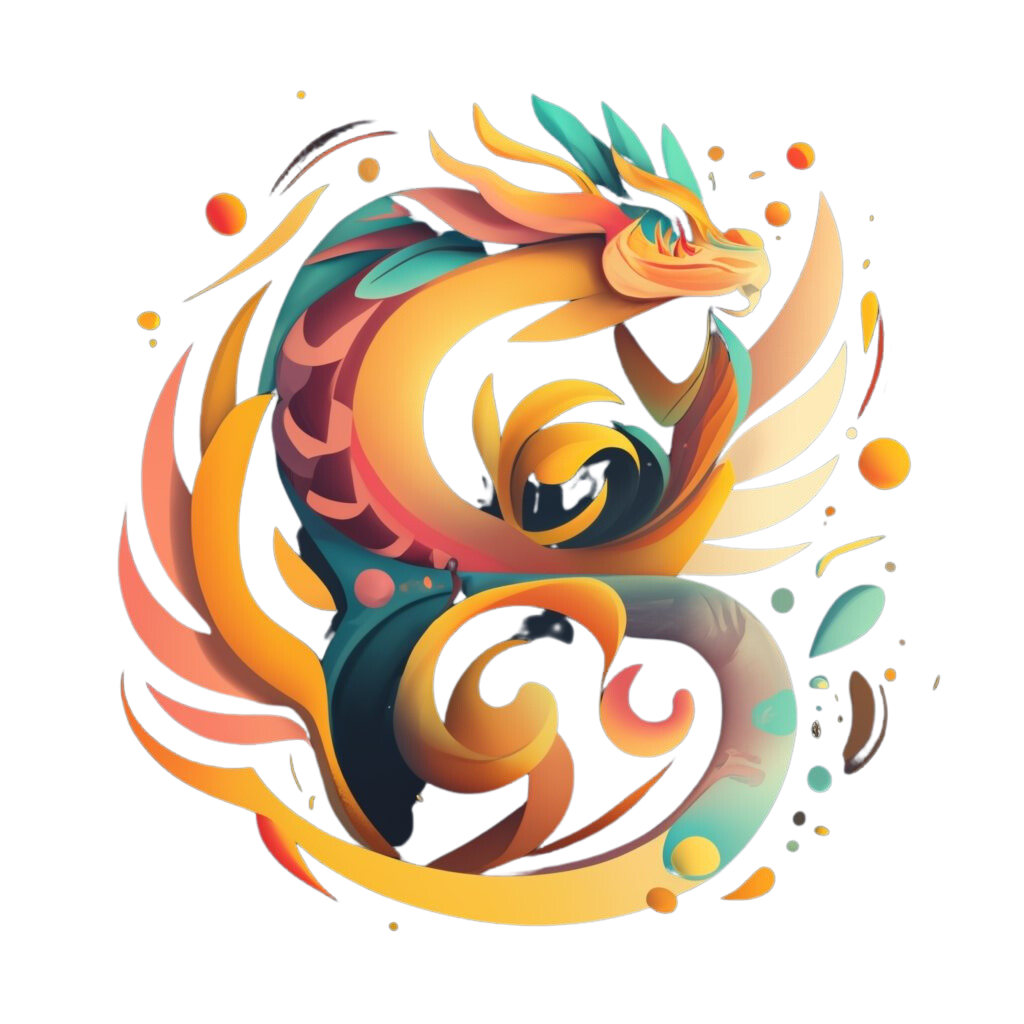Polynesian mythology is a world filled with mythical beings from Hawaii to New Zealand. These legends have shaped Pacific Island culture and identity for centuries. They are not just stories but carry deep meanings and symbolism.
We'll explore the stories of gods, goddesses, and supernatural creatures in Polynesian mythology. These tales have been kept alive through oral storytelling. They still influence Pacific Island culture and traditions today. If you love history, culture, or great stories, Polynesian mythology has something for you.
Key Takeaways
- Polynesian mythology is a rich and diverse world of Pacific legends and mythical beings.
- These legends have played a significant role in shaping the culture and identity of the Pacific Islands.
- The stories of Polynesian mythology carry deep meanings and symbolism, offering insights into the history, values, and beliefs of the people who created them.
- Oral storytelling has been an important way to preserve and pass down these legends.
- Polynesian mythology continues to influence the culture and traditions of the Pacific Islands today.
- The world of Polynesian mythology offers a unique blend of Pacific legends and mythical beings.
The Rich Tapestry of Polynesian Mythology
Polynesian folklore is a key part of the region's culture. It includes stories and legends passed down for generations. These tales come from ancient Pacific island cultures, where stories helped keep history and values alive.
At the heart of Polynesian mythology is oral storytelling. This art has made these legends grow and change over time. Through stories, mythical beings and supernatural entities are woven into the cultural fabric. They show the values, beliefs, and views of the Polynesian people.
Origins of Polynesian Mythological Traditions
The growth of Polynesian mythology is complex and varied. It was shaped by the interactions and migrations of different island cultures. This has led to a rich mix of stories, legends, and supernatural beings in Polynesian mythology.
Role of Oral Storytelling in Preserving Legends
Oral traditions have been key in keeping Polynesian mythology alive. They allow stories to be shared from one generation to the next. This tradition not only keeps cultural heritage alive but also helps create new stories and legends.
The Cultural Significance of Mythical Beings
Mythical beings and supernatural entities in Polynesian mythology are deeply meaningful. They reflect the values, beliefs, and views of the Polynesian people. These beings often represent qualities like bravery, wisdom, and spiritual connection.

Exploring Polynesian mythology helps us understand the region's cultural heritage and traditions. Through its stories and legends, we see the diversity and complexity of Polynesian cultures. It shows the importance of keeping these traditions alive for future generations.
Understanding the Realm of Polynesian Mythical Creatures
The Pacific Islands are home to a wide range of supernatural beings. These include gods, demigods, spirits, and monsters. The classification of these creatures shows the rich culture of the Polynesian people.
Some famous beings are the gods of the sky, earth, and sea. They are linked to natural events like storms and earthquakes. Spirits and monsters are seen as having special powers.
- Gods and demigods: These beings are often associated with natural phenomena and are believed to have supernatural powers.
- Spirits: These beings are often depicted as having supernatural abilities and are believed to inhabit the natural world.
- Monsters: These beings are often depicted as fearsome creatures with supernatural powers and are believed to inhabit the ocean and other natural environments.
Studying Polynesian supernatural beings gives us a peek into Pacific Island culture and spirituality. By looking at the different types of beings, we learn more about Polynesian mythology.

Divine Beings and Creation Stories
In Polynesian mythology, gods and creation stories are key to understanding the world's origins. The gods, with their powers, are thought to have formed the universe and the first humans.
Creation myths vary across Polynesian islands, yet they share common themes. For instance, the Maori of New Zealand believe in Tane, who split the sky from the earth. In contrast, Hawaiians believe in Kumulipo, who brought the world into being through birth and transformation.
The First Gods and Their Powers
The first gods in Polynesian myths are linked to nature, like the sun, moon, and sea. These gods have divine powers to keep the world balanced and orderly. Notable gods include Tangaroa, the sea god, and Tawhirimatea, the wind god.

Creation Myths Across Different Islands
Comparing creation myths across Polynesian islands shows both similarities and differences. While gods and goddesses change, the themes of creation and transformation remain common. Here's a table showing key creation myths from various islands:
| Island | Creation Myth | Gods and Goddesses |
|---|---|---|
| Hawaii | Kumulipo | Kumulipo, Kanaloa |
| New Zealand | Tane | Tane, Ranginui |
| Tahiti | Tangaroa | Tangaroa, Tawhirimatea |
The Birth of Humanity in Polynesian Lore
In Polynesian mythology, gods and goddesses are credited with creating humanity. Legends say the first humans were made by the gods to inhabit the earth and keep it balanced. These stories are crucial to Polynesian culture and traditions today.
Ocean Guardians and Sea Spirits
The oceans around Polynesian islands are home to many mythical creatures. These sea deities and spirits are key in marine mythology. They greatly influence islanders' lives and how they interact with the sea.
Some famous ocean guardians and sea spirits in Polynesian culture include:
- Tangaroa, the god of the sea and ruler of the ocean and its creatures
- Haumia, a spirit associated with the ocean's bounty and the harvest of seafood
- Ngaumutonga, a sea serpent said to have the power to control the tides and protect fishermen
Islanders deeply respect these ocean spirits. They believe these spirits can protect and provide for them. Learning about marine mythology and these creatures gives us a peek into Polynesian culture.

Exploring Polynesian sea deities and ocean spirits helps us understand the ocean's importance in island life. It shows how the ocean shapes their culture and traditions.
| Ocean Spirit | Role in Marine Mythology |
|---|---|
| Tangaroa | God of the sea and ruler of the ocean and its creatures |
| Haumia | Spirit associated with the ocean's bounty and the harvest of seafood |
| Ngaumutonga | Sea serpent with the power to control the tides and protect fishermen |
Legendary Shape-shifters and Tricksters
Polynesian shapeshifters have long fascinated people with their magical transformations and cunning exploits. These legendary characters, often depicted as tricksters, can change their form at will. This makes them formidable and intriguing figures in Polynesian mythology.
Maui, a demigod known for his cleverness and magical powers, is one of the most famous. His trickster tales have been passed down through generations. They entertain and educate about the importance of wit and cunning. Other notable shapeshifters include the Hawaiian goddess Pele, who could transform into a beautiful woman or a fiery lava flow, and the Maori trickster god Irawaru, who could change his shape to outwit his enemies.
Famous Polynesian Shapeshifters
- Maui: a demigod from Polynesian mythology known for his magical powers and trickster tales
- Pele: the Hawaiian goddess of fire and volcanoes, who could transform into a beautiful woman or a fiery lava flow
- Irawaru: the Maori trickster god, who could change his shape to outwit his enemies
These legendary shape-shifters and their magical transformations are key parts of Polynesian mythology. They teach valuable lessons about adaptability, cunning, and the power of imagination. Through their trickster tales, we can gain insight into the cultural significance of these mythical beings and the importance of preserving their stories for future generations.
Lessons Behind Trickster Stories
Trickster stories, like those of Polynesian shapeshifters, often contain valuable lessons and morals. They teach us about the importance of cleverness, adaptability, and creativity in overcoming challenges and achieving our goals. By studying these stories, we can gain a deeper understanding of the cultural values and traditions of the Polynesian people and appreciate the richness and diversity of their mythology.
Forest Spirits and Land Guardians
In Polynesian mythology, there are powerful beings called land guardians. They protect the islands' ecosystems. These spirits live in forests, mountains, and coastlines, keeping nature in balance.
The idea of forest mythology is central to Polynesian culture. The land is seen as sacred and connected to people's lives. Land guardians are linked to certain places, like ancient forests or sacred mountains. They have special powers to guard their territories.
- They protect the natural environment.
- They are tied to specific locations and territories.
- They have supernatural powers to defend against harm.
These traits show how vital land guardians are in Polynesian culture. They play a crucial role in keeping the ecosystem balanced.
Powerful Warriors and Mythical Heroes
In Polynesian mythology, legendary warriors and heroes are celebrated for their bravery and strength. Their epic quests are a big part of our cultural heritage. They inspire us with stories of adventure and courage.
Their stories are full of action, magic, and suspense. They are exciting for people of all ages. These heroes are known for their valor and determination.
Epic Tales of Legendary Warriors
Some famous warriors in Polynesian mythology went on epic quests. They sought new lands, defeated evil spirits, and brought prosperity. These stories remind us of the power of courage and perseverance.
Heroic Quests and Adventures
These warriors were known for their heroic quests and adventures. These quests tested their bravery, strength, wisdom, and cunning. By facing incredible challenges, they showed us the value of perseverance and determination.
| Legendary Warrior | Epic Quest | Outcome |
|---|---|---|
| Tamati | Defeat of the giant bird | Victory and prosperity for his people |
| Mataora | Discovery of new lands | Establishment of a new settlement |
Today, these legendary warriors and their quests inspire us. They remind us of the importance of courage, determination, and perseverance. Their stories are a big part of Polynesian culture, keeping their legacy alive.
Supernatural Beings in Modern Polynesian Culture
Today, Polynesian mythology is alive in the Pacific islands. It shapes art, literature, and pop culture. These old legends have mixed with new ideas, creating something unique.
Supernatural beings are seen in movies, books, and art. This shows how these old stories still matter today.
Many Pacific islanders still believe in spirits and gods. These beings are linked to nature and the land. This mix of old and new beliefs has shaped Polynesian cultures.
Here are some ways supernatural beings are seen in Polynesian culture today:
- Mythical creatures in art and literature
- Supernatural themes in movies and TV
- Traditional myths in modern music and dance
These examples show how ancient stories are still important today. They highlight the role of Polynesian mythology in shaping Pacific island cultures.
| Supernatural Being | Modern Interpretation | Cultural Significance |
|---|---|---|
| Spirits | Depicted in contemporary art and literature | Associated with natural phenomena and the land |
| Gods | Featured in film and television productions | Embodiment of traditional beliefs and values |
| Mythical Creatures | Incorporated in modern music and dance | Symbolism of cultural heritage and identity |
Regional Variations of Polynesian Mythical Creatures
Polynesian mythology is filled with stories and legends passed down for generations. It's fascinating to see the variety of mythical creatures across different cultures. From Hawaiian to Maori and Samoan, each culture has its own legendary beings. These reflect their history, values, and beliefs.
In Hawaiian mythology, we find the Menehune, small spirits said to have built ancient structures. Maori legends tell of the Taniwha, powerful spirits that control nature. Samoan folklore features the Tevolo, a mythical bird believed to bring good fortune.
Legendary Beings from Different Cultures
- Hawaiian mythology: Menehune, spirits that built ancient structures
- Maori legends: Taniwha, powerful spirits that control nature
- Samoan folklore: Tevolo, a mythical bird that brings good fortune
These legendary beings show the unique cultural heritage of each Polynesian culture. They also highlight common themes in Polynesian mythology. By exploring these variations, we can understand the rich cultural diversity of the Pacific Islands. It's crucial to preserve these stories for future generations.
Preserving the Magic of Polynesian Mythology
As we wrap up our look at Polynesian mythological creatures, it's clear these stories are very important. They hold a lot of preservation and mythological heritage value. The Polynesian storytelling traditions have created a world of enchanting legends. These stories inspire and captivate people all over the world.
It's important to keep these stories alive. They give us a peek into the spiritual beliefs and traditions of Pacific cultures. They also help us appreciate the diversity and strength of Polynesian communities. By documenting, translating, and sharing these stories, we can make sure the magic of Polynesian mythology is kept alive for future generations.
As you leave this journey through Polynesian mythical creatures, we urge you to keep exploring and celebrating these timeless tales. By embracing their wonder and wisdom, we can all help protect the legacy of Polynesian mythology. This way, its captivating spirit will continue to inspire for many years to come.
FAQ
What is the role of oral storytelling in preserving Polynesian legends?
Oral storytelling has been key in keeping Polynesian legends alive for ages. These stories have been shared through spoken words. This way, they've changed and grown within each island's culture.
How do Polynesian mythical beings reflect the cultural values and worldviews of the islands?
The mythical creatures of Polynesia show the values and beliefs of the islanders. They act as symbols, linking people to nature and their spiritual side. They also reflect the islanders' way of life.
What are some of the most powerful and influential Polynesian gods and creation myths?
Polynesian myths tell of mighty gods and demigods with special powers. These gods are key in creation stories, shaping the world and humanity's origins. They vary across different island cultures.
Can you provide examples of famous Polynesian shapeshifters and trickster characters?
Polynesian myths are famous for their shapeshifters and tricksters, like Maui. Maui could change into animals and got into all sorts of trouble. These characters teach important lessons and are cultural symbols.
How do Polynesian mythical creatures continue to influence modern culture in the Pacific islands?
Today, Polynesian mythical beings still shape island cultures. They inspire art, literature, and pop culture. Many islanders still believe in these supernatural beings, keeping their spiritual world alive.
Can you highlight the regional variations of Polynesian mythological creatures across different island cultures?
Polynesian myths share common themes but each island has its own legends. From Hawaii's creatures to the Maori's spirits and Samoan guardians, the variety shows the richness of Polynesian traditions.
